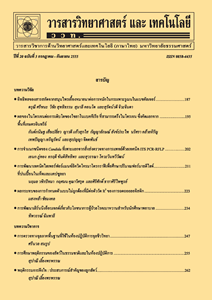สมบัติทางโครงสร้างและแม่เหล็กของ Fe3O4 เฟอร์ไรท์ด้วยวิธีเผาแคลไซน์ของผงหมึกเหลือใช้
Main Article Content
Abstract
Abstract
Waste toner was calcined at room temperature, 500, 700, 900 and 1,100 oC for 4 h. Structural, quantity of elements, morphology and magnetic properties were investigated by X-ray diffractometer (XRD), energy dispersive X-ray spectrometer (EDX), scanning electron microscope (SEM) and vibrating sample magnetometer (VSM). The waste toners that were calcined at room temperature and 500 oC were Fe3O4 ferrite and had inverse spinel cubic structure, whereas those calcined at 900 and 1,100 oC were a-Fe2O3 and had rhombohedral structure. The comparison of elements of room temperature compared to 500 oC of calcining revealed that Fe content increased from 32.28 to 47.50 %wt, but C content decreased from 40.35 to 6.96 %wt. The morphology of waste toners that was calcined at room temperature, 500 and 700 oC had spherical and average particles with the sizes of 208, 233 and 242 nm, respectively. However, when calcined at 900 and 1,100 oC the morphology of waste toners showed lager grain size. At the calcination temperature of 500 oC, the maximum saturation magnetization (Ms) and coercivity (Hc) of the waste toners were 73 emu/g and 70 Oe, respectively. The saturation magnetization of waste toner was significantly reduced when calcined at 900 oC with Ms = 1 emu/g due to the crystalline structure of Fe3O4 and ferromagnetic became anti-feromagnetic properties of a-Fe2O3.
Keywords: waste toner; calcination; ferrite
Article Details
References
[2] ปริญญา พงษ์สิน, ธนพงษ์ สุริเย และธีรพงศ์ นิรัตติวงศกรณ์, 2555, การประยุกต์ใช้การตรวจสอบโดยใช้อนุภาคแม่เหล็กในกระบวนการผลิตท่อบรรจุดินขับ, น. 1137-1143, การประชุมวิชาการข่ายงานวิศวกรรมอุตสาหการ, มหา วิทยาลัยศรีปทุม, กรุงเทพฯ.
[3] Yoshikazu, T., Masahide, N., Satoshi, H., Koichi, T. and Minoru, U., 2003, Synthesis of ferrite nanoparticles by mechano-chemical processing using a ball mill, Mater. Transact. 44: 277-284.
[4] ธีระพงษ์ พวงมะลิ, 2556, การนำส่งยาด้วยอนุภาคนาโนแม่เหล็ก : กระสุนจิ๋วพิชิตมะเร็ง, ว.วิทย. มข. 41(3): 607-620.
[5] Worawong, A., Jutarosaga, T. and Onreabroy, W., 2014, Influence of calcination temperature on synthesis of magnetite (Fe3O4) nanoparticles by sol-gel method, Adv. Mat. Res. 979: 208-211.
[6] Kazeminezhad, I. and Mosivand, S., 2014, Phase transition of electro-oxidized Fe3O4 to and -Fe2O3 Nanoparticles using sintering treatment, Acta. Phys. Pol. A 125:
1210-1214.
[7] Yotsakit, R., Nattapon, S., Kitipun, B., Patarawagee, Y. and Jakrapong, K., 2013, Characterization of rice straw ash and utilization in glass production, Ada. Mat. Res.748: 304-308.
[8] Hassadee, A., Jutarosaga, T. and Onreabroy, W., 2012, Effect of zinc substitution on structural and magnetic properties of cobalt ferrite, Proced. Eng. 32: 597-602.
[9] Nucharee, C., Darunee, B. and Tripob, B., 2010, Magnetic properties of magnetite nanoparticles synthesized by oxidative alkaline hydrolysis of iron powder, Kasetsart J. (Nat Sci.) 44: 963-971.
[10] Jalaly, M., Enayati, M.H., Kameli, P. and Karimzadeh, F., 2010, Effect of composition on structural and magnetic properties of nanocrystalline ball milled Ni1-xZnxFe2O4 ferrite, Physica B 405: 507-512.
[11] Raul, V., 2005, Magnetic ceramics, Cambridge University Press, Cambridge, 120 p.
[12] สุปรีดิ์ พินิจสุนทร, 2558, วัสดุแม่เหล็ก, ภาควิชาฟิสิกส์ คณะวิทยาศาสตร์ มหาวิยาลัยขอนแก่น, ขอนแก่น, 94 น.

